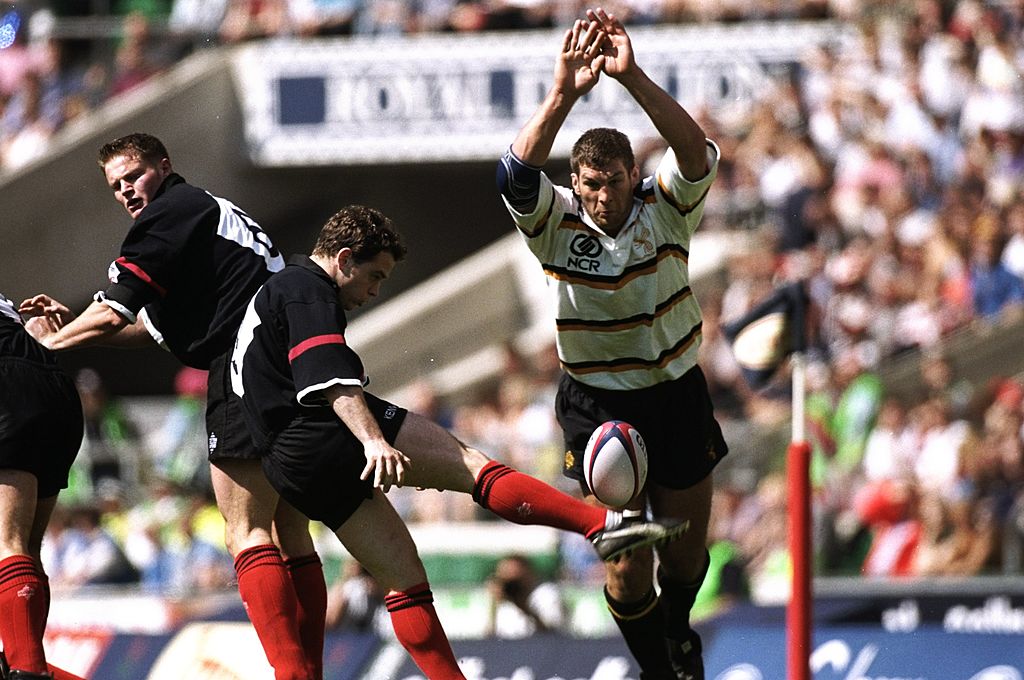Hewett column: Reduce the size of the bench? It can’t happen

9 May 1998: Simon Shaw of Wasps attempts to block the kick of Kyran Bracken of Saracens during the Tetley Bitter Cup final at Twickenham in London. Saracens won the match 48-18. Mandatory Credit: Alex Livesey/Allsport
When the Bristol tight-head prop Paul Guttridge was sent off during a league match with Leicester in front of a big crowd at the Memorial Ground in 1993, the home side responded in time-honoured fashion by ordering the youngest, most expendable member of their remaining pack to fill the hole in the front row.
Step forward Simon Shaw, a second row maestro in the making but at this point still a student in his teens.
No one doubted the kid’s physical potential – he looked as though he had been fed on steaks bigger than the animals from which they had been butchered – but at 6ft 9ins and drenched behind the ears, he did not seem quite the sort to pass an examination set by the Midlanders’ famously rigorous ‘ABC club’ of Graham Rowntree, Richard Cockerill and Darren Garforth.
Yet he somehow made it through the test, helping Bristol to one of their more memorable victories of the late amateur era – a time when emergency duty at the sharp end of the scrum was seen as a rite of passage.
“Get up there, son, and find your own salvation,” the elders and betters would say. “It’ll make a man of you.”
Those were the days, it is being said ever more frequently.
There were no tactical substitutions back then – the Leicester back rower Simon Povoas was the only replacement used during that contest in the West Country, introduced when Neil Back did himself a mischief early in the piece – and as far as the rugby cognoscenti were concerned, the only “finishers” to be found in their sport were Rory Underwood types, hanging around on the wing with clean shorts and unruffled hair.
Increasing numbers of supporters are yearning for at least a partial return to that simpler age, when every player who started a game was expected to finish it and the vast majority of forwards, even New Zealand sheep farmers and Welsh miners, spent the second half blowing out of their fundaments.
There were no “get out of jail free” cards: no cavalry off the bench, no merciful shepherd’s crook for the poor sod having a nightmare at scrum-half or full-back, no respite for the knackered.
As fatigue levels increased, so did the space on the field. It was 15 versus 15 and the devil take the hindmost.
Injury substitutions are now non-negotiable, an unchallengeable fact of rugby life.
Some of the highest courts in the land have already had their say on this matter and, as a consequence, the game’s administrators have no appetite for risking further entanglements in the dense undergrowth of tort law and vicarious liability by taking a cavalier approach to health and safety.
But most right-thinking folk would do away with personnel changes of the ‘tactical’ variety in a heartbeat, for they have been a blight on the game – a drop of poison in the well. Hence the recent demands for a reduction in bench numbers, from eight to six, or even five.
Unfortunately, things ain’t that simple. Why? Because people cheat during matches, just as they cheat when it comes to hiring people to play in them.
We don’t need to dwell on the “Bloodgate” saga of 2009 to recognise this truth, although the behaviour of Harlequins that day, and in the weeks following, was an unusually egregious example of rank chicanery.
We need only think of uncontested scrums and the sharp practices surrounding them to understand that dark forces are always at work in professional rugby.
Premiership semi-finals and finals have been distorted by top coaches pulling fast ones at the set-piece.
So have Six Nations internationals, in full view of audiences measured in the millions. It is not a good look, but hey, who cares as long as we win?
If rugby was suddenly reclaimed as a sport of collective attrition and endurance rather than individual power through the restriction of substitutions to injury situations alone, how long would it take someone, somewhere, to game the system by instructing an under-performing liability of a player to develop a limp or invent a sore shoulder or feign an outbreak of leprosy? Less than an hour, probably.
And before anyone suggests such double-dealing could easily be minimised, or even eradicated, by independent medical check-ups, there is not the remotest chance of a doctor risking his or her career by giving a player the once-over and saying: “Mate, there’s nothing wrong with you. Get back out there.” Not in our lifetimes. Not ever.
It is just over 40 years since the England prop Robin Cowling stayed on the field in Paris after dislocating a shoulder and continued scrummaging against the great Robert Paparemborde.
It is a little over a quarter of a century since Shaw not only survived his labours against Leicester, but somehow ended the afternoon the same height as he began it.
This is the stuff of rugby legend, and there are countless other examples. But that’s the thing with legends. They speak only of the past, not of the present – or, indeed, of the future.